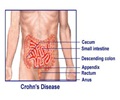CT has good sensitivity for the detecting colon cancers with tumors that have spread beyond bowel wall, however, it remains a challenge in detecting nodal involvement.

‘The use of thin slice CT improved the detection of tumor invasion beyond the bowel wall, as well as the detection of malignant lymph nodes.’





"Detecting nodal involvement with CT is unreliable," Elias Nerad,
radiologist at Catharina Hospital Eindhoven and researcher at
Netherlands Cancer Institute in Amsterdam, The Netherlands, said. "The use of thin slices improved the detection of tumor invasion beyond the bowel wall, as well as the detection of malignant lymph nodes, and is therefore advocated. Also, evidence suggests that CT colonography improves the accuracy of CT in the local staging of colon tumors, which could have a major clinical effect if neoadjuvant chemotherapy is adopted in the treatment of colon cancer."
CT colonography is a technique that uses optimal bowel wall distention and 3D reconstruction of the colon (creating a virtual colonoscopy), which distinguishes it from regular CT of the abdomen. The meta-analysis provided by study coauthor Nerad, et al. was limited to two CT colonography studies because the majority of them identified in the literature search included rectal tumors that were inseparable from the colon tumors and thus were excluded.
Nerad said, "Furthermore, CT colonography can also be used as a (local) staging tool, making it a very interesting potential subgroup in our meta-analysis."
Overall, the research was based on the meta-analysis of 13 studies describing the accuracy of CT in the staging of colon carcinomas. In the literature, colon and rectal cancers are combined despite the fact that they differ in terms of anatomy, diagnostic workup, and treatment. This study does make a clear distinction between the two and aims to exclusively determine the diagnostic accuracy of CT for staging colon cancer only and to evaluate whether CT can help in differentiating high- from low-risk colon cancer tumors.
Advertisement
In contrast, colon cancer is mainly staged with CT and there are no guidelines for the use of neoadjuvant treatment for colon cancer. However, this will most likely change in the near future, if ongoing studies confirm earlier reports that patients with aggressive colon tumors benefit from a neoadjuvant treatment.
Advertisement
Source-Eurekalert















